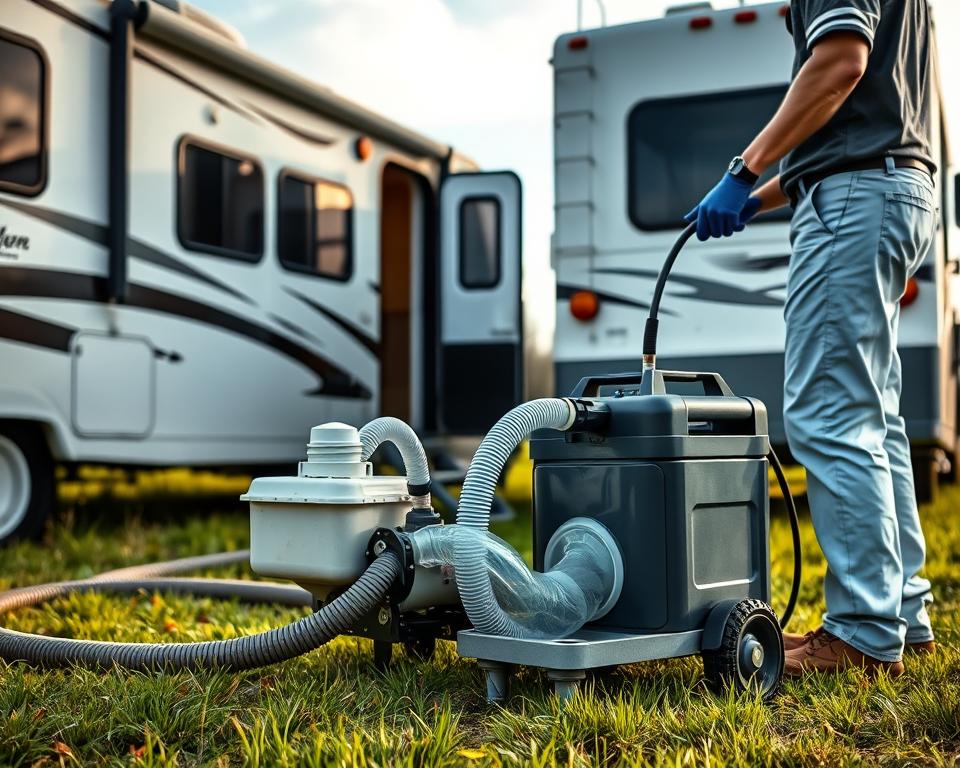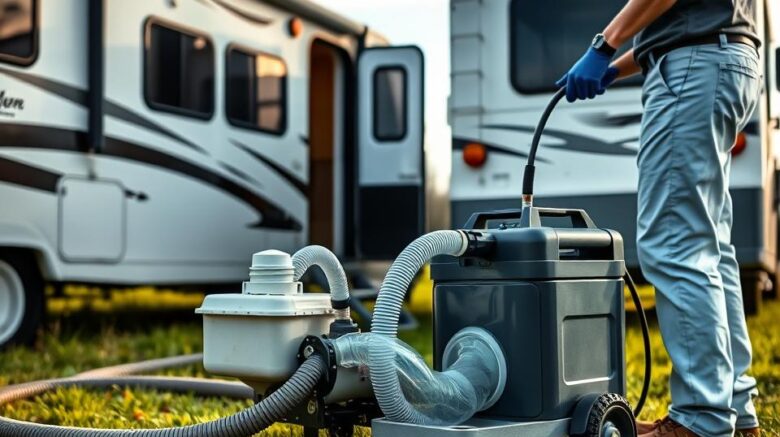Motorhome Water Tank and Pump: – Essential Handbook
Have you ever asked how seasoned RVers ensure perfect water flow while dry-camping? It’s all about your RV water Tank and Pump. From venturing into the national-park circuit or just a weekend retreat, commanding your RV’s water system is crucial. In this guide we dive into the fundamentals: the components, upkeep, and best practices for trouble-free travel. Grasping each element, from the linework to reservoir filling, ensures water is always ready during your excursions – RV septic service near me.
Critical Notes
- Mastering the RV fresh-water setup elevates your travel fun.
- The RV fresh-water Tank & Pump are central for a steady water supply.
- Routine maintenance ensures the service life of your RV plumbing.
- Knowing proper fill techniques for your Tank properly can avert future issues.
- Diagnosing your water Pump can spare you sudden problems.
Breaking Down RV Water Systems
RV water systems are split into two principal parts: the fresh-water setup and the used-water mechanism. The fresh side houses several core components like the water Tank, Pump, and faucets, echoing household plumbing but adapted to the dynamic needs of road living.
Using potable water is paramount for the system’s performance. It guarantees the health of all passengers. It’s imperative to keep the RV plumbing in prime condition through routine maintenance – including proper drainage to avoid leaks and other hiccups. Timely inspections enable RV enthusiasts avoid water-related headaches during their journeys.

The Role of the RV Water Tank
The RV water Tank is key for a seamless journey. It stores the fresh water required for drinking, cooking, and cleaning. The volume of this container varies with each RV model, affecting how much water can be stored – and this directly influences how long you can stay off-grid before needing a refill.
Ensuring the RV storage Tank hygienic is critical. Regular cleaning wards off dangerous contaminants, ensuring water stays safe for use. Ignoring maintenance can cause bacteria or algae growth, making the water hazardous.
Recognising the RV Tank’s role enhances water management on the road. Consistent upkeep and regular refills deliver a care-free experience. It’s crucial to have ample water for all travel needs, ensuring a smooth RV adventure.
Topping Up Your RV Fresh-Water Tank
Refilling your RV fresh-water reservoir calls for attentive action to confirm it’s done correctly. There are two main methods: gravity filling and city-pressure filling. Perfecting these methods significantly enhances your RV water routine.
Gravity-feed is simple. All you need a potable water hose. Connect this hose to a water source, then to the Tank’s opening, and let gravity take over. Be sure to watch the water level to prevent spills.
Pressure filling uses a city water connection, which is faster fill times. You should use a pressure regulator to govern water flow. Connect the hose from the municipal source to your RV. This approach provides quick and steady supply to your Tank.
Either method you prefer, adhere to these key safety tips: Always monitor the fill when filling to prevent overflow, and draw only clean water to avoid health issues. Knowing these filling and safety techniques will turn your RV trips even more enjoyable.
RV Water Tank and Pump: Key Components Explored
The RV water Tank and Pump are vital to any RV’s plumbing system, ensuring a reliable and smooth water supply for all your needs. The RV water Pump’s main job is to draw water from the Tank, so clean water is always on call. That’s key for cooking, cleaning, and showering.
RV plumbing utilises different Pump types, each with individual benefits. Diaphragm pumps are prized for their even water pressure, while centrifugal pumps are prized for mechanical simplicity and energy thrift. It’s important to weigh flow rate, noise, and installation ease when selecting your Pump.
To wrap up, the RV water Tank and Pump are irreplaceable to your water system’s functioning. A robust Pump delivers strong pressure and smooth flow, improving your overall travel experience.
Selecting the Right RV Water Pump
Finding the appropriate RV water Pump is vital for your plumbing’s best performance. When picking a Pump, weighing a few points is important for a positive camping experience. Ensuring it pairs with your RV’s water system is key.
Keep these important aspects in mind:
- Flow Rate: Choose a Pump with a flow rate that suits your usage requirements. A higher flow means faster reservoir refills.
- Pressure Ratings: Your RV’s multiple fixtures set the required pressure levels. Pick a Pump whose specs match those needs for smooth operation.
- Noise Levels: Noise can be an issue with some Pumps. For peace and quiet, check models for their noise output.
Brands like Shurflo and VEVOR are high on the list for many RVers, each offering unique features. A careful assessment of these brands will guide your purchase process.
Understanding these factors is not only crucial for the proper purchase but also arms DIY enthusiasts with essential know-how for upkeep and replacements.
Using City Water for Your RV
Connecting your RV to city water allows for an effortless supply of fresh water, freeing you from just using your Tank. This delivers a more enjoyable camping experience. Make sure to follow safe steps for a successful hookup.
First, locate the city water connection port on your RV. It’s often marked by a white or black connector, sometimes marked for ease. Use a potable water hose designed for RVs; this grade of hose keeps your water safe from contaminants.
It’s critical to attach a pressure regulator before making the connection. This fitting protects your plumbing by taming the water pressure. With the regulator in place, connect the hose from it to the water source.
Once connected, keep an eye on the water pressure. Aim for a steady, gentle flow to prevent hose damage. Inspect your hoses regularly for any wear or leaks and promptly replace parts as needed.
Following these steps for city hookup improves your camping convenience and assists in maintaining your RV’s condition.
Maintaining Your RV Fresh-Water Tank
Keeping your RV’s fresh-water reservoir is in good order is essential for safe, clean water while on the road. A well-maintained Tank avoids bacterial growth and contamination. First up, regularly sanitise the Tank: mix water with a bit of bleach for an effective residue-free clean.
It’s important to watch for leaks and manage Tank pressure. Routine checks can identify problems early, sparing expensive fixes. A maintenance routine keeps the water system in excellent health.
For optimal maintenance, use a checklist:
- Check water levels and quality frequently.
- Sanitise the Tank bi-annually with a bleach solution.
- Inspect for seepage in the reservoir.
- Monitor Tank pressure and Pump function.
- Flush the Tank to eliminate any sediment buildup.
RV Water Pump Diagnostics
RV water Pump glitches can be frustrating, upending travel plans in a flash. Facing strange noises, experiencing low pressure, or suffering complete Pump failure are typical problems. Learning how to troubleshoot them can greatly improve your trips.
Hearing odd sounds from your Pump often signals a problem. First step : check for loose connections and secure them. When you face low water pressure, inspect hoses and fittings for leaks. Even a minuscule leak can dramatically affect flow, early troubleshooting is essential.
If your Pump stops altogether, check electrical connections. Begin by examining the Pump’s fuse. Should the fuse is fine, dig deeper for wear or damage.
A step-by-step routine pinpoints and resolves water system issues. Routine maintenance and inspection secure hassle-free journeys.
| Issue | Possible Cause | Suggested Solution |
|---|---|---|
| Strange Noises | Loose connections | Tighten fittings |
| Low Pressure | Leaky hoses/fittings | Find & seal leaks |
| Pump Failure | Electrical fault | Check fuse/wiring |
| No Water Flow | Blocked lines | Flush obstructions |
Hacks for Effective RV Water Use
Boondocking in off-grid areas typically entails limited water access. Economical use in your RV is crucial. By embracing smart conservation tactics, you don’t just manage resources well but also elevate camping satisfaction.
To make the most of water on the road, consider these tips:
- Take brief showers – aim for under five minutes.
- Install water-saving fixtures like low-flow showerheads and faucets.
- Reuse used water: dishwater can flush toilets or water plants.
- Monitor reservoir levels regularly to prevent overflow.
- Plan water stops in advance: know filling stations along your route.
Final Thoughts
Mastering the ins and outs of your RV water systems is key to a fulfilling travel adventure. The Tank and Pump are at the heart of this, demanding routine upkeep. By looking after these systems, you guarantee a dependable supply and sidestep potential snags.
Consistent troubleshooting and checks limit stress and save time. Being proactive about upkeep is crucial, especially when you’re far from help. Proper care enables you to optimise water use, raising comfort for everyone.
When you head out, keep this guide to master your RV’s water systems. Making informed choices about plumbing and equipment prepare you to relish the freedom of the road. Here’s to happy and smooth travels ahead!
